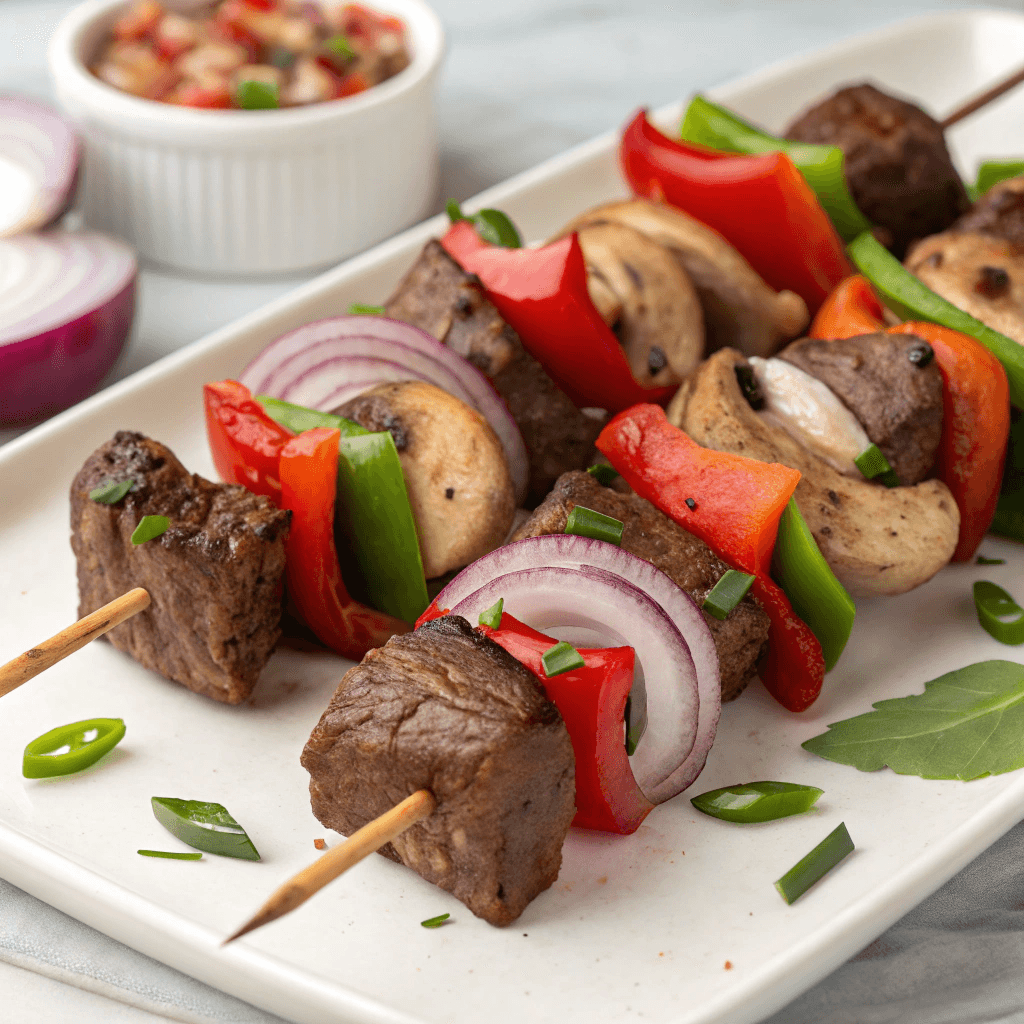Balanced Korean Sanjeok:Skewers of Flavor
Sanjeok, Korean meat and vegetable skewers, offers a delightful blend of flavors and textures. Learn its history, preparation and variations!
Introduction: A Taste of Tradition
Korean cuisine, known for its bold flavors and vibrant dishes, continues to captivate food lovers worldwide. Among its many culinary treasures, Sanjeok stands out as a visually appealing and delicious dish. This is mainly because they are not only delicious but also hold significant cultural importance. Therefore, in this comprehensive guide, we will delve into the world of Sanjeok, exploring its historical roots, cultural significance, preparation techniques, and different variations. Moreover, we aim to provide you with everything you need to create and enjoy this wonderful dish at home.

The History and Cultural Significance of Sanjeok
Ancient Roots of Skewered Delights
The history of Sanjeok can be traced back to the Joseon Dynasty, where it was a staple in royal banquets and aristocratic meals. Furthermore, these skewered delicacies were a display of culinary prowess and social status. Therefore, the careful arrangement of ingredients on the skewers showcased the skill and attention to detail that were highly valued. These elaborate skewers were more than just food, they represented a cultural tradition.
Religious and Ritualistic Uses of Sanjeok
Beyond its role in grand feasts, Sanjeok has a significant place in Korean ancestral veneration ceremonies, particularly Charye. Consequently, during traditional Korean holidays like Chuseok (Korean Thanksgiving), families prepare Sanjeok to honor their ancestors, as the presentation is as important as the taste. Additionally, each element, from the type of meat to the specific vegetables, has a symbolic meaning, reflecting the deep-rooted traditions of Korean culture. The careful placement of each skewer is not random; it conveys respect and is an integral part of the ritual.
Symbolism and Traditions Behind Sanjeok Ingredients
The ingredients used in Sanjeok are not arbitrary; instead, they often carry symbolic meaning. For example, using different types of meat, such as beef, signifies respect, while using seasonal vegetables reflects the connection with nature. Therefore, the traditional art of slicing and skewering ensures even cooking and an attractive presentation. Moreover, this meticulous approach is a testament to the deep cultural significance of Sanjeok. In addition, the act of preparing Sanjeok is often a family affair, passing down these traditions from generation to generation.
Evolution of Sanjeok Through Time
Over the centuries, Sanjeok has evolved, adapting to changes in available ingredients and cooking methods. However, while some variations have emerged, the essence of Sanjeok remains unchanged. Therefore, this enduring tradition allows us to glimpse a piece of Korean history. Furthermore, regional variations add subtle nuances to the dish, highlighting the diverse culinary landscape of Korea.
Deconstructing the Elements: Essential Sanjeok Ingredients
Choosing the Right Meats for Sanjeok
The choice of meat is crucial for Sanjeok, impacting both the flavor and the texture. Therefore, the most popular options include beef, often using bulgogi-style cuts for tenderness. In addition, thinly sliced meat cooks quickly and evenly on the skewers. Furthermore, these meats are typically marinated to enhance their taste and create a more tender texture. The marinating process is vital for infusing flavor into the meats.
Traditional Vegetables for Sanjeok
Vegetables provide a crucial balance to the richness of the meat in Sanjeok. For example, the classic pairings include colorful bell peppers, which offer a touch of sweetness. In addition, onions contribute a savory note, while green onions provide a fresh sharpness. Furthermore, mushrooms, such as shiitake or button mushrooms, add an earthy depth. Therefore, these vegetables are not only delicious but also visually appealing. Moreover, the method of preparation for these vegetables ensures they cook well on the grill or pan without becoming soggy.
The Art of the Sanjeok Marinade
The marinade is what elevates Sanjeok from simple skewers to a flavourful dish. Therefore, common base components include soy sauce, sesame oil, garlic, and ginger. In addition, a touch of sugar balances the savory elements. Furthermore, variations exist, allowing for customization to personal tastes. The purpose of the marinade is to tenderize the meat and infuse it with a delicious umami taste. For example, some recipes also add a touch of mirin for extra sweetness.
Skewers and Equipment for Perfect Sanjeok
Using the right skewers is essential for making Sanjeok. Therefore, both wooden and metal skewers are suitable, but each has different benefits. In addition, wooden skewers are inexpensive but may need soaking to prevent burning. Metal skewers are reusable and provide even heat distribution for cooking. Furthermore, the right equipment can make the preparation process much easier, which will include a grill or pan, bowls, and cutting boards. For safety, it is essential to handle the skewers with care, particularly if the skewers are wooden and sharp.
Mastering Sanjeok: Step-by-Step Preparation Guide
Detailed Steps for Meat, Vegetables and Skewers
Preparing Sanjeok involves several key steps, each requiring care and attention. Therefore, start with selecting high-quality meat and slicing it into thin, even pieces. In addition, the marinating process is essential. In fact, place sliced meat in a marinade for at least 30 minutes. Furthermore, prepare your vegetables by washing and slicing them into pieces that are similar in size. After that, begin assembling your skewers, arranging the meat and vegetables in an alternating pattern. The key here is to ensure even distribution of ingredients.
How to Grill or Pan-fry Sanjeok
Cooking Sanjeok can be achieved on a grill or in a pan. For grilling, preheat the grill to medium-high heat before carefully placing the skewers on the grates. Therefore, it is crucial to turn them every few minutes to ensure even cooking and a slight char. Alternatively, pan-frying is a great option for those who do not have access to a grill. Add a touch of oil to the pan and cook the skewers until the meat is cooked through and the vegetables are tender. Therefore, it is vital to monitor the cooking temperature, as the meat can dry out quickly if the temperature is too high. Moreover, the proper cooking technique is essential for creating a perfectly cooked Sanjeok.
Common Sanjeok Mistakes & How to Avoid Them
Several common mistakes can compromise the quality of your Sanjeok. For example, uneven cooking is a common issue. This can occur when the ingredients are not cut evenly. Furthermore, dry meat is another problem. It usually happens when the meat is overcooked. In addition, soggy vegetables can result from overcrowding the pan or cooking them for too long. Therefore, to avoid these issues, pay attention to marinating times, ingredient placement, and cooking temperatures. By understanding these challenges, you can ensure your Sanjeok is perfect every time.

Variations of Sanjeok: A World of Flavors
Classic Beef Sanjeok: A Culinary Standard
Beef Sanjeok is arguably the most popular variation. Therefore, thinly sliced beef, marinated in a rich blend of soy sauce and sesame oil, becomes incredibly tender and flavorful. In addition, its traditional preparation makes it a classic choice at any gathering. Furthermore, its versatility means that it can be made to suit different tastes with simple adjustments to the marinade. This makes it an ideal starting point for anyone new to Sanjeok.
Savory Pork Sanjeok: A Rich Alternative
Pork Sanjeok offers a unique flavor profile, using cuts like pork belly for a richer, fattier taste. Therefore, marinades can be adjusted to complement the pork’s natural flavors, creating a delicious alternative to beef. For example, some marinades include a touch of gochujang for a subtle spicy kick. In addition, pork versions are often enjoyed for their savory and satisfying taste.
Lighter Chicken Sanjeok: A Healthier Option
Chicken Sanjeok is a lighter option, using chicken thighs or breasts for a lean protein source. Therefore, marinade variations for chicken often include citrus or herbs to enhance its delicate flavor. Furthermore, this is a healthy and delicious way to experience Sanjeok, suitable for those looking for a lighter meal. In addition, this version is more family-friendly option.
Seafood Sanjeok: Adding the Taste of the Sea
Sanjeok can also feature seafood, such as shrimp and squid. Therefore, these ingredients provide an alternative option for those who do not like red meat. These seafood options also require different preparation to avoid overcooking. In addition, a simple marinade of garlic and ginger can bring out their natural flavors.
Plant-Based Sanjeok: Tofu and Mushrooms
For vegetarians and vegans, Sanjeok can be easily adapted using tofu and vegetables. Therefore, firm tofu, marinated and grilled, can replicate the texture of meat. Additionally, various mushrooms, such as shiitake and oyster mushrooms, also provide a savory, meaty texture. Moreover, the incorporation of seasonal vegetables adds a touch of freshness. Consequently, this makes it an inclusive dish that everyone can enjoy.
Regional Variations of Sanjeok
Within Korea, there are regional variations in Sanjeok, each adding a unique twist to the traditional dish. Therefore, some regions may use different marinades or incorporate unique local ingredients. Furthermore, these subtle variations provide a glimpse into the diverse culinary landscape of Korea. In addition, each variation showcases the creativity and adaptability of Korean home cooking.
Serving and Enjoying Sanjeok
Traditional Sanjeok Presentation and Dipping Sauces
Sanjeok is traditionally served on a platter, accompanied by a variety of banchan (side dishes). In addition, soy sauce-based dipping sauces with a touch of sesame oil are commonly used. The presentation is an important part of the dining experience, as it adds to the visual appeal of the dish. Therefore, the arrangement of the Sanjeok on the platter is often as important as the flavors.
Contemporary Serving Ideas for Sanjeok
Sanjeok is also highly versatile and can be incorporated into various modern dishes. For example, they can be added to salads, rice bowls, or used as a protein in sandwiches and wraps. In addition, they can be paired with contemporary side dishes, creating new and exciting flavor combinations. Furthermore, these creative ways of serving Sanjeok highlight its adaptability to different culinary styles.
Best Beverages to Pair with Sanjeok
Pairing Sanjeok with the right beverages can enhance the dining experience. Therefore, herbal teas and water are always great choices as they complement the savory flavors of the skewers. The right beverage pairing elevates the meal by complementing rather than overpowering the main dish.
Storing Leftover Sanjeok
Leftover Sanjeok can be stored in the refrigerator for a few days. Therefore, to reheat, either pan-fry them gently or use a microwave. In addition, it’s essential to ensure they are thoroughly heated before consuming. Storing leftover Sanjeok in an airtight container also ensures it retains its freshness.

Sanjeok in the US: Exploring Korean Flavors
Finding Sanjeok at Korean Restaurants in the US
Many Korean restaurants in the US serve Sanjeok, often as part of a larger barbecue or banchan offering. Therefore, seeking out local Korean restaurants is a great way to experience authentic Sanjeok. In addition, these restaurants can offer variations of the dish, providing new and exciting culinary experiences. Moreover, exploring these different options is a great way to discover your favorite style of Sanjeok.
The Joy of Making Sanjeok at Home
With the information provided in this article, making Sanjeok at home is not only possible but also enjoyable. Therefore, you have now all the tools and tips you need to recreate this delicious dish and share your creations with friends and family. In addition, home-cooked Sanjeok allows for even more personalization and creativity.
Detailed Recipe for Sanjeok
Here is a detailed recipe to guide you through making perfect Sanjeok:
Ingredients:
- 1 lb beef sirloin, thinly sliced (or any preferred meat)
- 1 large onion, sliced
- 1 bell pepper (any color), sliced
- 1 cup mushrooms (such as shiitake or button), sliced
- 1 green onion, sliced
- 1 zucchini, sliced
- 1/4 cup soy sauce
- 2 tablespoons sesame oil
- 2 cloves garlic, minced
- 1 tablespoon grated ginger
- 1 tablespoon sugar (or honey)
- Wooden or metal skewers
- Vegetable oil, for cooking
Instructions:
- Prepare the Marinade: In a medium bowl, whisk together soy sauce, sesame oil, minced garlic, grated ginger, and sugar until well combined.
- Marinate the Meat: Place the thinly sliced meat in the bowl with the marinade, making sure each piece is well coated. Let it marinate for at least 30 minutes, or up to a few hours, in the refrigerator for a deeper flavor.
- Prepare the Vegetables: While the meat marinates, slice the onion, bell pepper, mushrooms, green onions, and zucchini into similar-sized pieces to ensure they cook evenly.
- Assemble the Skewers: Thread the marinated meat and the vegetables alternately onto the skewers, making sure to leave a little space between each piece.
- Cook the Sanjeok:
- Grilling: Preheat your grill to medium-high heat. Place the skewers on the grill and cook for about 2-3 minutes per side, or until the meat is fully cooked and has a slight char.
- Pan-frying: Heat a little vegetable oil in a large pan over medium heat. Place the skewers in the pan, making sure not to overcrowd. Cook for about 2-3 minutes per side, or until the meat is fully cooked and slightly browned and the vegetables are tender.
- Serve Immediately: Serve the Sanjeok hot, ideally with some dipping sauce on the side and other Korean side dishes.

Nutritional Information (Per 100g, approximate values):
| Nutrient | Amount |
| Calories | 180 kcal |
| Protein | 18g |
| Fat | 10g |
| Saturated Fat | 2g |
| Carbohydrates | 5g |
| Sugar | 2g |
| Sodium | 400 mg |
Sanjeok FAQ: Your Burning Questions Answered
What is Sanjeok?
Sanjeok is a traditional Korean dish consisting of marinated meat and vegetables skewered and grilled or pan-fried. Therefore, it is often enjoyed during special occasions and family gatherings.
What is Jijim Nureumjeok?
Jijim Nureumjeok is another type of Korean pan-fried skewer, similar to Sanjeok. However, the ingredients are often lightly coated in flour or egg batter before cooking. Therefore, this gives them a slightly crispier texture.
What is Pasanjeok?
Pasanjeok, unlike Sanjeok, are savory Korean pancakes with various ingredients and green onion (pa) often used as a main ingredient. The preparation methods are different because Pasanjeok ingredients are mixed in a batter instead of being skewered like Sanjeok.
Conclusion: A Culinary Journey with Sanjeok
Sanjeok is more than just a delicious meal; it’s a cultural experience that brings together history, tradition, and culinary artistry. Therefore, we encourage you to explore this incredible dish, whether in a restaurant or by creating your own at home. The process is as rewarding as the result, leaving you with a delightful taste of Korean cuisine. In addition, Sanjeok is a great recipe to start your journey into the world of Korean cooking. Moreover, you will see that it is a great way to explore the diverse flavors and techniques of Korean cuisine. Why not try making it for your next family gathering?
General Korean Cuisine & Culture:
- Maangchi’s Website:https://www.maangchi.com/
- Why: Maangchi is a well-known Korean cooking authority with tons of recipes, videos, and cultural information. It’s a great place for beginners to explore a wide range of Korean dishes beyond Sanjeok.
- Korean Bapsang:https://www.koreanbapsang.com/
- Why: This blog offers detailed recipes, cultural insights, and beautiful photography of Korean dishes. It provides a deeper understanding of the food’s context and traditions.
- My Korean Kitchen:https://mykoreankitchen.com/
- Why: Another excellent resource for authentic Korean recipes, this site focuses on simple, easy-to-follow instructions, perfect for home cooks.
if you liked our recipe you can check another one like this ;
Jangjorim: The one Delicious Korean Braised Beef







